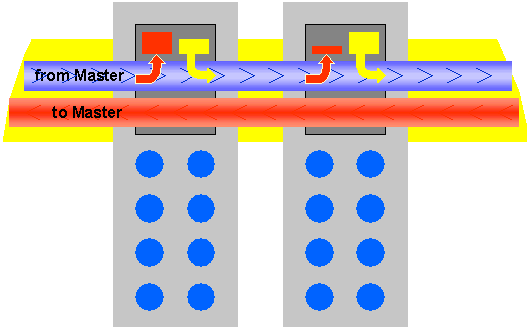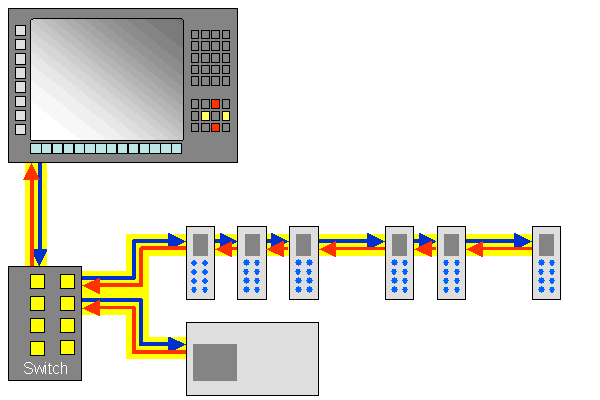New approach
EtherCAT technology overcomes these inherent limitations of other Ethernet solutions: the Ethernet packet is no longer received, then interpreted and copied as process data at every connection. The newly developed FMMU (fieldbus memory management unit) in each I/O terminal reads the data addressed to it, whilst the telegram continues through the device. Similarly, input data are inserted while the telegram passes through. The telegrams are only delayed by a few nanoseconds.

Fig. 1: Dynamic telegram processing
Since an Ethernet frame reaches the data of many devices both in send and receive direction, the usable data rate increases to approx. 80%. The full-duplex features of 100BaseTx are fully utilized, so that effective data rates of > 100 Mbit/s (up to 80% of 2 x 100 Mbit/s) can be achieved.
Ethernet up to the terminal
The Ethernet protocol conforms to IEEE 802.3 remains intact right up to the individual terminals; no sub-bus is required. Only the transfer physics is converted in the coupler from twisted pair or optical fiber physics to E-bus, in order to meet the requirements of the electronic terminal block.

Fig. 2: Full duplex Ethernet in the ring, one frame for many devices. The EtherCAT system architecture increases the communication efficiency.
On the control side, the TwinCAT Y driver for Ethernet complements the FMMU technology. This integrates transparently into the system, so that it appears as an operating system-compatible network driver, and additionally as a TwinCAT fieldbus card. An internal prioritization and buffer is provided at the transmitter end which always finds a free transmission channel for Ethernet frames from the real-time system that may be queuing. The operating system's Ethernet frames are only a later transmitted in the gaps if sufficient time is available.
At the receiving end, all the Ethernet frames received are examined by the TwinCAT I/O system, and those with real-time relevance are filtered out. All other frames are passed on to the operating system after examination, outside the context of the real-time system.

Fig. 3: Operating system-compatible TwinCAT Y driver:
Very inexpensive, commercially available standard network interface cards (NIC) are used as hardware in the controller. The data transfer to the PC takes place via DMA (direct memory access). Therefore, no CPU performance is lost for network access.
Since the Ethernet functionality of the operating system is fully maintained, all operating system-compatible protocols can be operated in parallel on the same physical network. This not only includes standard IT-protocols such as TCP/IP, HTTP, FTP or SOAP, but also practically all Industrial-Ethernet-protocols such as Modbus TCP, ProfiNet or Ethernet/IP.